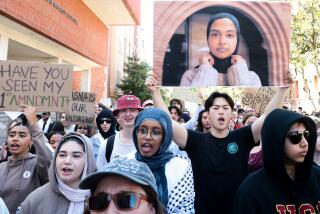CSU Chancellor Gives Bleak Lesson : Higher Education: Tuition increase or more state funding is needed to prevent further staff and class cuts next year, Munitz tells SDSU faculty and students.
San Diego State University students and faculty got the bad news about their future directly from the top Thursday.
Without student fee increases, a greater share of state tax money or some combination of both, there will be fewer students and fewer classes as well as staff salaries that fail to keep up with the cost of living, Barry Munitz, chancellor of the California State University system, said.
In daylong meetings with professors and students, Munitz expressed sympathy with students upset at a proposed 40% fee increase and with instructors worried that a lack of salary increases for the second year in a row would worsen morale.
But he held out little expectation of an improved picture anytime soon, citing the state’s bleak budget picture and lack of appreciation he finds among the public for the role that the CSU system could play in improving California’s future.
In an afternoon give-and-take, students vented their frustration over the proposed fee increase, which comes on top of a 20% increase this year. The proposed increases would raise student costs $372, $1,078 to $1,450 for a full academic year.
That proposal requires a two-thirds vote of the state Legislature, a vote Munitz said would fail if held Thursday because the increase is politically sensitive for legislators to approve in an election year.
In such a case, or without some compromise reducing the level of fee increases, the CSU system could raise fees only 10%, leaving more than a $100-million gap in its 1992-93 budget.
“It’s not enough just to ask that there be no fee increases,” Munitz said. “You have got to ask for some (additional) general fund money as an alternative for the faculty and the rest of the university so we can begin to put some of the 5,000 classes we cut this year back in.”
Why not make those “who reaped riches in the 1980s pay more?” student Berge Pechtimaldjian asked Munitz. “They could pay more. . . . You should be more aggressive and tell the Legislature not to put this on students . . . but to make the most wealthy pay.”
Pechtimaldjian labeled as akin to “blackmail” the choice given to students to either accept fee increases or see enrollments cut and classes eliminated, similar to what happened at SDSU this year because of state budget woes.
If the 40% increase goes through, SDSU probably will not have to make any further academic-related cuts, President Thomas Day said last week.
“I certainly don’t mean to paint (the picture) as blackmail for students,” Munitz said, agreeing with Pechtimaldjian that the ideal solution would be to not only receive more state tax dollars this year but also to get a commitment for a higher percentage in the future.
“The burden is (funding CSU) being transferred from the taxpayer to students and families . . . for me, that is unacceptable. But without either (increase) in fees or taxes, either the quality of education will go down or the number of years it takes” for a student to graduate will go up, Munitz said.
Student suggestions to cut more administrators or to eliminate custodians and have cleaning done by students themselves would fail to raise a large amount of money or would violate labor and other legal agreements, Munitz said.
“In the past two years, we have cut 1,000 administrative jobs. But when you talk about administration now, you are talking about health counselors, librarians, financial aide workers, those who deliver what you want,” he told the students.
But Munitz said that, not only does it appear that the state has no more tax money to give the system, but the overall budget picture is growing worse, and the existing level of funding may have to be cut.
In talking with both professors and students, Munitz said the short-term problem cannot be separated from the question of whether Californians want to continue their traditional commitment to public higher education.
The state master plan for higher education assures students graduating in the top one-third of their high school class admission to one of the 20 California State University campuses.
“Without more money, we are not going to be able to meet” that commitment, Munitz said, pointing out that the system’s share of the state budget has dropped from 4.62% in 1985-86 to 3.53% proposed by Gov. Pete Wilson for next year.
“With a $50-billion budget, that 1%, or $500 million, could sure be put to good use,” Munitz said.
“You have to get out and tell the story of what we do.”
Munitz already has plans to tap major corporations as well as some of the well-heeled among 2 million CSU graduates in the state.
“I don’t believe we can prosper without them,” he said. “It’s very difficult to do on state tax dollars alone.”
More to Read
Start your day right
Sign up for Essential California for news, features and recommendations from the L.A. Times and beyond in your inbox six days a week.
You may occasionally receive promotional content from the Los Angeles Times.






